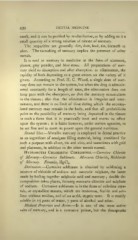Page 422 - My FlipBook
P. 422
420 DENTAL MEDICINE.
smell, and it can be purified by re-distillation, or by adding to it a
small quantity of a strong solution of nitrate of mercury.
The impurities are generally dirt, dust, lead, tin, bismuth or
zinc. The tarnishing of mercury implies the presence of other
metals.
It is used as mercury in medicine in the form of ointment,
plaster, gray powder, and blue mass. All preparations of mer-
cury yield to absorption and after absorption to elimination, the
rapidity of both depending to a great extent on the variety of it
given. According to Prof. H. C. Wood, a single dose of mer-
cury does not remain in the system, but when the drug is adminis-
tered constantly for a length of time, the elimination does not
keep pace with the absorption, so that the mercury accumulates
in the tissues ; also that the elimination is irregular and inter-
mittent, and there is no limit of time during which the accumu-
lated mercury may remain in the body, and that all probabilities
point to the possibility of mercury being deposited in the tissues
in such a form that it is practically inert and exerts no effect
upon the system ; it is liable however, under certain agencies, to
be set free and to exert its power upon the general nutrition.
Dental Uses.— Metallic mercury is employed in dental practice
as an ingredient of amalgam filling material, being combined for
such a purpose with silver, tin and zinc, and sometimes with gold
and platinum, in addition to the other metals named.
Hydrargyri Chloridum Corrosivum.— Corrosive Chloride
of Mercury— Corrosive Sublimate. Mercuric Chloride^ Bichloride
of Mercury. Formula.^ HgClg.
Derivation.—Corrosive sublimate is obtained by subliming a
mixture of chloride of sodium and mercuric sulphate, the latter
made by boiling together sulphuric acid and mercury ; double de-
composition takes places, forming mercuric chloride and sulphate
of sodium. Corrosive sublimate is in the form of colorless crys-
tals, or crystalline masses, which are inodorous, fusible and sub-
lime without residue, and of an acrid, styptic taste. It is readily
soluble in 15 parts of water, parts of alcohol and ether.
7
Medical Properties and Action.—It is one of the most active
salts of mercury, and is a corrosive poison, but the therapeutic


